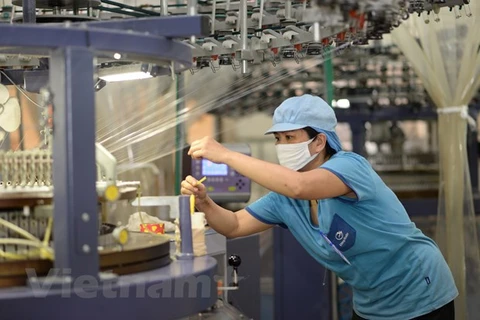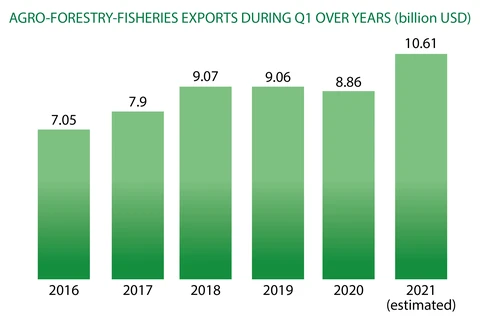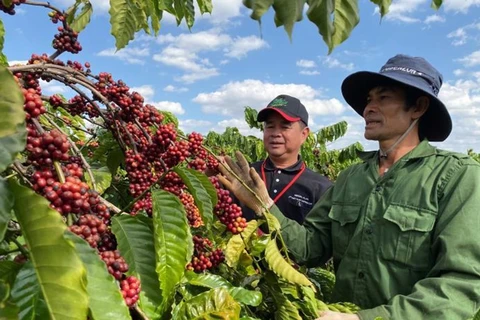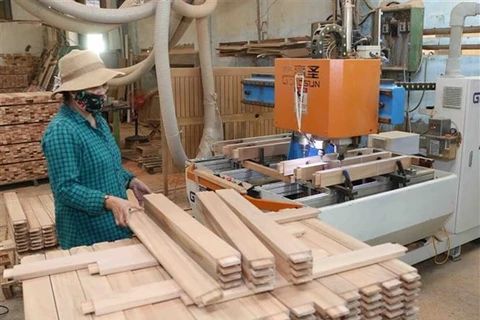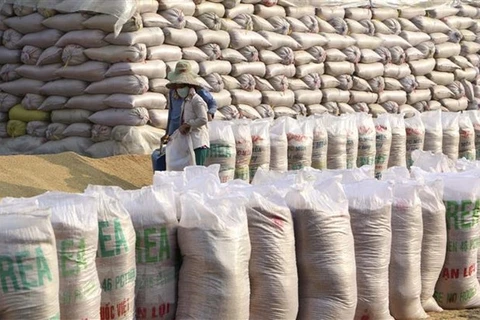Hanoi (VNA) – Hanoi earned 3.118 billion USD from exports in the first quarter of 2021, dropping 1 percent from the same period last year, according to the municipal Department of Industry and Trade.
Of the total, more than 1.6 billion USD came from shipments by domestic businesses, down 9.3 percent, and over 1.15 billion USD from foreign invested firms, up 9.7 percent.
Some commodities posting export growth in Q1 included mobile phones and accessories (92.4 million USD, up 110 percent), footwear (77.6 million USD, up 24.6 percent), and glass and glassware products (83.7 million USD, up 17.8 percent).
Those with shrunken shipments were transport vehicles and spare parts (283.3 million USD, down 15.7 percent), agricultural products (141.3 million USD, down 30 percent), and petrol and oil (127.1 million USD, down 42.4 percent).
Meanwhile, the capital imported almost 6.99 billion USD worth of goods in the first three months, up 4 percent year on year, including 5.38 billion USD by domestic enterprises and 1.6 billion USD by foreign invested ones, up 4 percent and 4.1 percent, respectively.
Explaining the export contraction in Q1, Acting Director of the Department of Industry and Trade Tran Thi Phuong Lan said complex developments of the COVID-19 pandemic in the key export markets like the US, Europe, and Southeast Asia have continued to adversely impact exports, leading to a sharp decline the shipments of vehicles and spare parts, petrol, and oil.
According to the Ministry of Industry and Trade, Vietnam’s export turnover in the first three months was estimated at 77.34 billion USD, up 22 percent year-on-year.
Products posting the highest turnover included phones and components (14.08 billion USD), computers, electronic devices and components (11.96 billion USD), and machinery, equipment and spare parts (9.1 billion USD).
Agro-forestry-fishery exports, despite being hit hard by COVID-19, brought in approximately 5.97 billion USD, an annual increase of 6.6 percent.
The growth was attributable to companies effectively taking advantage of new-generation free trade agreements.
Cao Quoc Hung, Deputy Minister of Industry and Trade, said that since the EU-Vietnam Free Trade Agreement (EVFTA) took effect in August last year, Vietnam’s exports to the bloc have been rising and grew 18 percent in the first quarter.
Vietnam also posted high growth in export value to members of the Comprehensive and Progressive Agreement for Trans-Pacific Partnership (CPTPP), such as Canada (up 13.7 percent), Australia (17 percent), Chile (25.6 percent), and Mexico (12.7 percent).
Optimising the advantages from FTAs is a key factor in stimulating Vietnam’s exports in the time to come, Hung said.
Vietnam’s imports in the first quarter, meanwhile, stood at 75.31 billion USD, a year-on-year increase of 26.3 percent.
Of the total import value, 66.1 billion USD came from purchasing raw materials and accessories for domestic production. This shows that firms are preparing for a new business cycle after the COVID-19 pandemic.
Ho Le Tung, general director of the Hanoi Textile & Garment JSC (Hanosimex), said that yarn has sold well in the market since the fourth quarter of last year.
Hanosimex’s yarn factories are working at full capacity, as the company has contracts until May, he added.
Vietnam posted a trade surplus of 2.03 billion USD in the first quarter, supporting its current and overall payment balance.
But its exports are forecast to face continued difficulties due to COVID-19, which may cause further interruptions to supply chains.
To accomplish the target set for the year, the Ministry of Industry and Trade is intensifying export promotion activities, including those online, to support businesses./.
Of the total, more than 1.6 billion USD came from shipments by domestic businesses, down 9.3 percent, and over 1.15 billion USD from foreign invested firms, up 9.7 percent.
Some commodities posting export growth in Q1 included mobile phones and accessories (92.4 million USD, up 110 percent), footwear (77.6 million USD, up 24.6 percent), and glass and glassware products (83.7 million USD, up 17.8 percent).
Those with shrunken shipments were transport vehicles and spare parts (283.3 million USD, down 15.7 percent), agricultural products (141.3 million USD, down 30 percent), and petrol and oil (127.1 million USD, down 42.4 percent).
Meanwhile, the capital imported almost 6.99 billion USD worth of goods in the first three months, up 4 percent year on year, including 5.38 billion USD by domestic enterprises and 1.6 billion USD by foreign invested ones, up 4 percent and 4.1 percent, respectively.
Explaining the export contraction in Q1, Acting Director of the Department of Industry and Trade Tran Thi Phuong Lan said complex developments of the COVID-19 pandemic in the key export markets like the US, Europe, and Southeast Asia have continued to adversely impact exports, leading to a sharp decline the shipments of vehicles and spare parts, petrol, and oil.
According to the Ministry of Industry and Trade, Vietnam’s export turnover in the first three months was estimated at 77.34 billion USD, up 22 percent year-on-year.
Products posting the highest turnover included phones and components (14.08 billion USD), computers, electronic devices and components (11.96 billion USD), and machinery, equipment and spare parts (9.1 billion USD).
Agro-forestry-fishery exports, despite being hit hard by COVID-19, brought in approximately 5.97 billion USD, an annual increase of 6.6 percent.
The growth was attributable to companies effectively taking advantage of new-generation free trade agreements.
Cao Quoc Hung, Deputy Minister of Industry and Trade, said that since the EU-Vietnam Free Trade Agreement (EVFTA) took effect in August last year, Vietnam’s exports to the bloc have been rising and grew 18 percent in the first quarter.
Vietnam also posted high growth in export value to members of the Comprehensive and Progressive Agreement for Trans-Pacific Partnership (CPTPP), such as Canada (up 13.7 percent), Australia (17 percent), Chile (25.6 percent), and Mexico (12.7 percent).
Optimising the advantages from FTAs is a key factor in stimulating Vietnam’s exports in the time to come, Hung said.
Vietnam’s imports in the first quarter, meanwhile, stood at 75.31 billion USD, a year-on-year increase of 26.3 percent.
Of the total import value, 66.1 billion USD came from purchasing raw materials and accessories for domestic production. This shows that firms are preparing for a new business cycle after the COVID-19 pandemic.
Ho Le Tung, general director of the Hanoi Textile & Garment JSC (Hanosimex), said that yarn has sold well in the market since the fourth quarter of last year.
Hanosimex’s yarn factories are working at full capacity, as the company has contracts until May, he added.
Vietnam posted a trade surplus of 2.03 billion USD in the first quarter, supporting its current and overall payment balance.
But its exports are forecast to face continued difficulties due to COVID-19, which may cause further interruptions to supply chains.
To accomplish the target set for the year, the Ministry of Industry and Trade is intensifying export promotion activities, including those online, to support businesses./.
VNA

